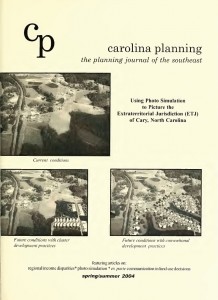 Volume 29.2 Forging Ahead and Lagging Behind (2004)
Volume 29.2 Forging Ahead and Lagging Behind (2004)
Editors: Helen Chaney, Naomi Cytron, Adena Messinger, and Jane Sibley
A digital version of this issue is available here.
| FORGING AHEAD AND LAGGING BEHIND: AN ANALYSIS OF CONVERGENCE AND DEVELOPMENT IN NORTH CAROLINA
Wubneh, Mulatu This paper analyzes trends in economic development in North Carolina to determine whether there has been evidence of per capita income convergence in the state during the period 1970-2000. The analyses reveal that (a) there has been a process of convergence of per capita income in the state in the past three decades, and (b) income convergence in NC occurred during a period of economic expansion and divergence during economic decline. However, a comparative analysis of metro and non-metro counties as well as among traditional geographic areas indicates that there was a general trend of divergence in metro areas and convergence in non-metro areas. This trend suggests that there are pockets of affluence and pockets of poverty existing side by side in the state. The regression analyses reveal that while the initial level of per capita income, human resource development and population growth had a significant impact on income growth, the impact of urbanization and investment in infrastructure was weak. The analysis on economic structure shows that employment in manufacturing had a major impact but employment in agriculture and services did not. |
| A CAROLINA PLANNING JOURNAL RETROSPECTIVE: BRIDGING THE PRACTICE-EDUCATION GAP
Godschalk, David David Godschalk has served as the faculty advisor for Carolina Planning since the journal was launched in 1975. He now shares his experience with the CP community. |
| A CASE STUDY IN THE USE OF PHOTO SIMULATIONS IN LOCAL PLANNING
Ramage, Scott F.; Holmes, Michael V. The Town of Cary employed photographic simulations in four separate comprehensive planning projects during the period 2000-2003. The four projects covered a range of downtown, suburban, and rural planning environments within Cary’s planning jurisdiction, making Cary’s experience applicable to most types of local jurisdictions. This paper describes how photographic simulation was used in three of these planning projects, and evaluates the effectiveness, tips, and lessons learned for each project. |
| BENDING THE JUDGE’S EAR: EX PARTE CONTACTS IN QUASI-JUDICIAL LAND USE DECISIONS
Terrell, Thomas E., Jr. Land use decisions by local government often affect property rights. Under certain conditions, the decision-making process is held to quasi-judicial standards. These standards include restricting communication between affected parties and the decision-makers to an official hearing. Not all affected parties, such as neighborhood residents, may know about these ex parte rules and might unintentionally violate them. This article explores ways to educate participants in the process to limit ex parte communication and ensure a fair process for all involved. |